Enhanced TDS
Identification & Functionality
- CASE Ingredients Functions
- Chemical Family
- Function
- Diluent,Reactive Diluent
- Industrial Additives Functions
- Technologies
- Product Families
Features & Benefits
- CASE Ingredients Features
- Industrial Additives Features
- Labeling Claims
- Properties
Due to their structure, reactive diluents have low viscosity. ARALDITE® DY 31 is a polymer.
The incorporation of ARALDITE® DY 31 has the following effects:
- A reduction of viscosity when used in a Standard Epoxy resin
- High reactivity is maintained (potentially increased)
- Practically no reduction of hardness
- A slight decrease of warm water resistance
- A slight reduction of acid resistance
- High resistance to solvents and ammonia
- The best diluent for Glass Transition retention
The reactive diluent in the resin component should not exceed 20%.
Applications & Uses
- Adhesive & Sealant End Applications
- Applicable Processes
- Coating End Applications
- Industrial Additives End Use
- Markets
- Applications
- Application Information
Unmodified bisphenol-A and bisphenol-A/F epoxy resins - such as ARALDITE® GY 250, GY260, GY 261, GY 266, PY 302-2 or PY 304 - are mixed with ARALDITE® DY 31 to produce low-viscosity epoxy resins for solvent-free coatings, flooring compounds and Adhesive/mastics.
ARALDITE® DY 31 should preferably be used when reactivity, hardness and resistance to warm water, solvents and ammonia are to be maintained.- 100% Solids chemical resistant coatings
- Concrete crack repair
- Coatings for containment areas
- High-performance adhesives
Regulatory & Compliance
- Certifications & Compliance
- Chemical Inventories
Technical Details & Test Data
- Performance Data
ARALDITE® DY-31 high-performance reactive diluent
Reduce viscosity of a standard Epoxy resin while maintaining Tg of the formulations, mechanical and chemical resistance properties. CMR-freeDilution without sacrificing functionality nor hydrophobicity
Size of Bubble Viscosity (mPa.s)
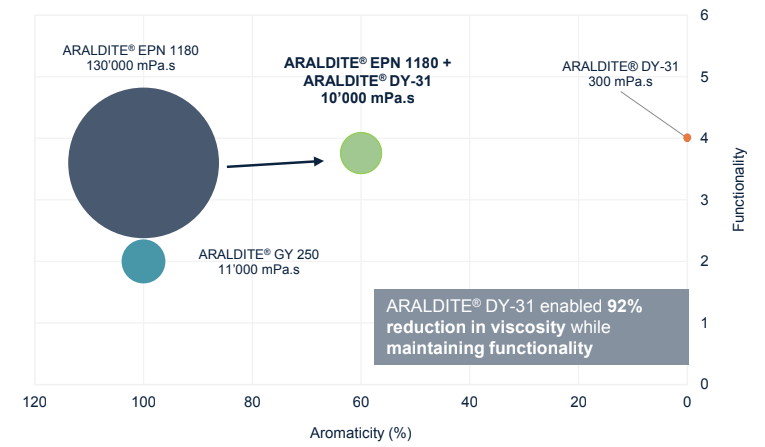
Size of Bubble proportional to water absorption after 3 d in boiling water Name (--%)
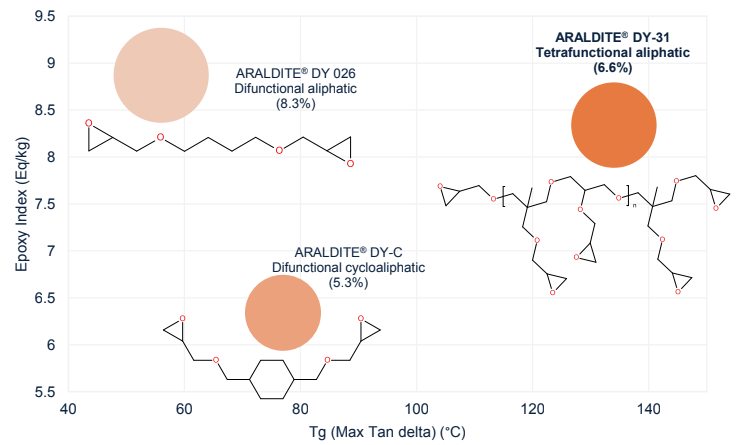
- Test Data
Comparison of ARALDITE® DY 31 with ARALDITE® DY-T: Mechanical properties when fully cured with ARADUR® 20315. Resin + hardener mixed at stoichiometry Cure profile: 1 h at 80°C + 1 h at 120°C + 1 h at 150°C Epoxy content of ARALDITE® DY 31 being higher than ARALDITE® DY-T leads to a different ratio between resin and hardener leading to a Higher Tg and a lower elongation at break. Other parameters are very similar.
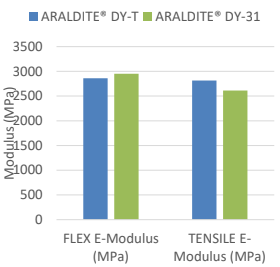
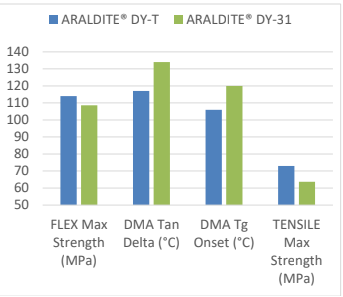
Size of Bubble proportional to resin viscosity (mPa.s)
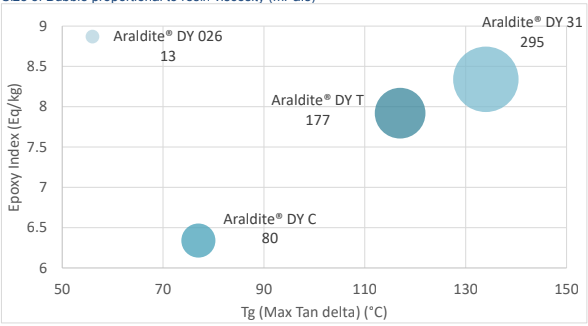
- Technical Graphs
The larger epoxy content of ARALDITE® DY-31 vs. ARALDITE® DY-T leads to a different ratio between resin and hardener resulting in a higher glass transition temperature and a lower elongation at break.

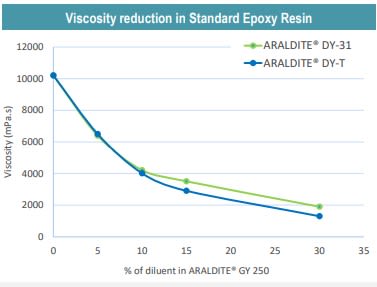
ARALDITE® epoxy resins fully cured with IPDA based hardener ARADUR® 20315 mixed at stoichiometry I Cure profile: 1 h at 80°C + 1 h at 120°C + 1 h at 150°C
Packaging & Availability
- Regional Availability
Storage & Handling
- Storage Information
- ARALDITE® DY 31 should be stored in a dry place, preferably in the sealed original container, at temperatures between 2 and 40 °C. The product should not be stored exposed to direct sunlight.
- Handling Information
- Mandatory and recommended industrial hygiene procedures should be followed whenever our products are being handled and processed.
Other
- Appearance
- Clear liquid
- Color (SDS)
- Yellow
- Immiscible In (SDS)
- Water
- Odor
- Slight
- Physical Properties
Value Units Test Method / Conditions Glass Transition Temperature (Tg) 134.0 °C °C Viscosity 200.0-400.0 mPa.s mPa.s Falling Ball Viscometer at 25°C Viscosity 200.0-400.0 mPa.s mPa.s ISO 12058 at 25°C
